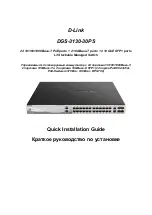
Page | 27
Section 6: Making Network Connections
6.0 Connecting to
a Network Devices
The switch is designed to be connected to 10, 100 or 1000Mbps network
cards in PCs and servers, as well as, to other switches and hubs. It may
also be connected to remote devices using optional SFP transceivers.
6.1 Twisted-Pair
Devices
Each device requires an unshielded twisted-pair (UTP) cable with RJ45
connectors at both ends. Use Category 5, 5e or 6 cables for 1000BASE-
T connections, Category 5 or better for 100BASE-TX connections.
6.2 Cabling
Guidelines
The RJ45 ports on the switch support automatic MDI/MDI-X pin-out
configuration, so you can use standard straight-through twisted-pair
cables to connect to any other network device (PCs, servers, switches,
routers, or hubs).
See Appendix B for further information on cabling.
CAUTION:
Do not plug a phone jack connector into an RJ45
port. This will damage the switch. Use only twisted-pair cables
with RJ45 connectors that conform to FCC standards.
6.3 Connecting to
PCs, Servers,
Hubs and
Switches
Step 1.
Attach one end of a twisted-
pair cable segment to the device’s
RJ45 connector.
Figure 16: Making Twisted-Pair Connections
Summary of Contents for MaxiiNet Vi30018
Page 15: ...Page 15 SFP Interface Guide 118 Connecting Vi30018 121 Contact Information 122...
Page 19: ...Page 19 3 4 Vi30018 Front View 3 5 Vi30018 Rear View...
Page 34: ...Page 34 After logging in the following page will appear Full Version Lite Version...
Page 39: ...Page 39...
Page 63: ...Page 63...
Page 66: ...Page 66 13 1 Drop and Receive Packet 13 2 CRC error packet and Receive Packet...
Page 73: ...Page 73...
Page 74: ...Page 74 Section 15 Security 15 0 MAC Address Binding...
Page 82: ...Page 82...
Page 85: ...Page 85...
Page 86: ...Page 86...
Page 87: ...Page 87...
Page 88: ...Page 88...
Page 92: ...Page 92...
















































